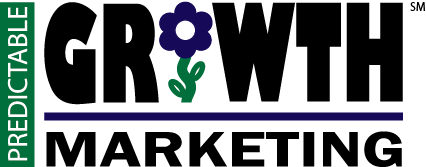
What is predictable growth? How can you create predictable growth in your business?
Small companies often start to grow haphazardly. The product or services comes on the heels of an initial inspiration – perhaps an identified gap in the market or perhaps an initial customer request to build a custom solution. At the start, it might be easy to find a few customers through referrals, cold outreach and hard work. But as you continue to try to grow, you need to find ways to get efficient at how you identify and close new customers.
To gain new funding, hire more employees, and service more customers, you need to build and refine repeatable processes. By using a systematic approach to identify, nurture and engage with potential customers, you can build predictable models for how gain new customers. This is where Marketing can play a huge role.
Often small, growing companies start out with sales development roles before hiring their first marketing function. Marketing is seen as an expense that a small company cannot afford, until they have more customers. But, today, as fewer prospects pick up phone calls and no one opens unrequested emails, marketing is playing a larger role in the sales process and it’s an important function to have even at an early stage.
Getting the attention of the right contacts has never been harder. The tactics that worked to gain your first 10 or 20 customers won’t work to gain your first 100 or 1000 customers. Marketing can play an important role in in building repeatable practices in multiple ways – from defining and building the brand as a differentiator, to developing programs to attract and educate prospective customers and even leveraging existing customers to deepen relationships and expand referral sales.
Marketing isn’t just advertising. A lot of companies think of Marketing in terms of dollars spent on Google Ads or Tradeshows and Events. But Marketing is a lot more complex than an expense line in your accounting software. At smaller, growing companies, Marketing can play a huge role in defining what your product/service is—what is unique about your offer that sets it apart from competitors’?—and arm your sales teams with the knowledge and resources they need to effectively explain this to potential customers.
To be sure, advertising and other lead generation activities often play a role in Marketing’s success at building predictable growth. You need to be constantly testing new channels, analyzing what’s working and reinvesting in what’s working while cutting what’s not. Getting accurate data and reports on where new sales are originating, and the steps that influence the decision, is a key element of creating a predictable model for growth. You need to be able to understand your customers, why they buy from you, and why stay customers to identify (or groom) these attributes in prospects. It’s the process of looking closely at these questions and learning from it that results in predictable growth, rather than any individual activity.
Rather than chasing every possible customer, you need to focus on the right customers. When trying to grow, it can be tempting to chase every possible lead and try to sell what you have to anyone who will take your calls. But it’s important to understand when a potential customer isn’t a good fit, so you can avoid wasting your sales team’s time and leaving the customer unhappy. Knowing who the right customers are and focusing your efforts on look-alike prospects is an important step in a predictable growth model.
Predictable growth requires ongoing analysis and experimentation to discover what works for your specific organization and increase the output of those activities to deliver return on your investments and avoid wasting time and money in the process. By diving deep into the data on your existing acquisition tactics and results, you can uncover a wealth of information to inform better practices and enable more impactful actions.


